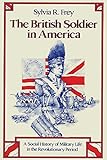The British Soldier in America : A Social History of Military Life in the Revolutionary Period / Sylvia R. Frey.
Material type: TextPublisher: Austin : University of Texas Press, [2021]Copyright date: ©1981Description: 1 online resource (224 p.)Content type:
TextPublisher: Austin : University of Texas Press, [2021]Copyright date: ©1981Description: 1 online resource (224 p.)Content type: - 9780292749276
- 973.3/41
- online - DeGruyter
| Item type | Current library | Call number | URL | Status | Notes | Barcode | |
|---|---|---|---|---|---|---|---|
 eBook
eBook
|
Biblioteca "Angelicum" Pont. Univ. S.Tommaso d'Aquino Nuvola online | online - DeGruyter (Browse shelf(Opens below)) | Online access | Not for loan (Accesso limitato) | Accesso per gli utenti autorizzati / Access for authorized users | (dgr)9780292749276 |
Browsing Biblioteca "Angelicum" Pont. Univ. S.Tommaso d'Aquino shelves, Shelving location: Nuvola online Close shelf browser (Hides shelf browser)

|

|

|

|

|

|

|
||
| online - DeGruyter The Cross Timbers : Memories of a North Texas Boyhood / | online - DeGruyter Tribes, Treaties, and Constitutional Tribulations / | online - DeGruyter The Writer's Reference Guide to Spanish / | online - DeGruyter The British Soldier in America : A Social History of Military Life in the Revolutionary Period / | online - DeGruyter Gay as a Grig : Memories of a North Texas Girlhood / | online - DeGruyter Recollections of Early Texas : Memoirs of John Holland Jenkins / | online - DeGruyter Platero and I / |
Frontmatter -- Contents -- TABLES -- Acknowledgments -- Introduction -- 1. Volunteers and Conscripts -- 2. Diseases and Doctors -- 3. Rewards and Recreation -- 4. Crimes and Courts -- 5. Training and Campaigning -- 6. Bonds and Banners -- Conclusion -- Appendix. Parliamentary Debate on Responsibility for the British Loss in America -- Notes -- Bibliography -- Index
restricted access online access with authorization star
http://purl.org/coar/access_right/c_16ec
In her investigation of the social history of the common British soldier in the era of the American Revolution, Sylvia Frey has extensively surveyed recruiting records, contemporary training manuals, statutes, and memoirs in an attempt to provide insight into the soldier's "life and mind." In the process she has discovered more about the common soldier than anyone thought possible: his social origins and occupational background, his size, age, and general physical condition, his personal economics and daily existence. Her findings dispel the traditional assumption that the army was made up largely of criminals and social misfits. Special attention is given to soldiering as an occupation. Focusing on two of the major campaigns of the war—the Northern Campaign which culminated at Saratoga and the Southern Campaign which ended at Yorktown—Frey describes the human face of war, with particular emphasis on the physical and psychic strains of campaigning in the eighteenth century. Perhaps the most important part of the work is the analysis of the moral and material factors which induced men to accept the high risks of soldiering. Frey rejects the traditional assumption that soldiers were motivated to fight exclusively by fear and force and argues instead that the primary motivation to battle was generated by regimental esprit, which in the eighteenth century substituted for patriotism. After analyzing the sources of esprit, she concludes that it was the sustaining force for morale in a long and discouraging war. This book is a contribution to our understanding of the eighteenth century and should appeal not only to military historians but also to social and economic historians and to those interested in the history of medicine.
Mode of access: Internet via World Wide Web.
In English.
Description based on online resource; title from PDF title page (publisher's Web site, viewed 26. Apr 2022)


